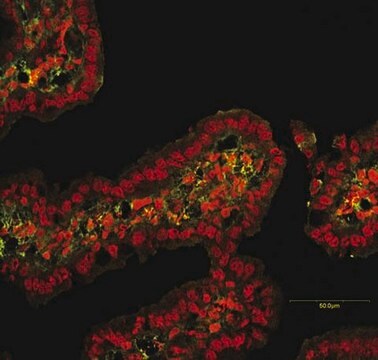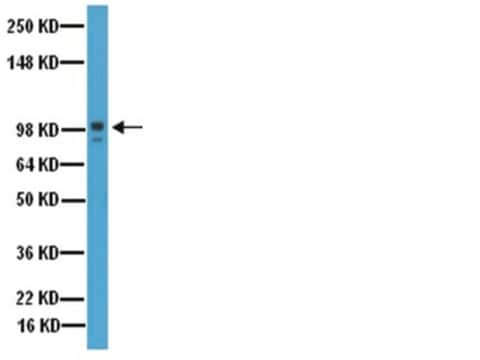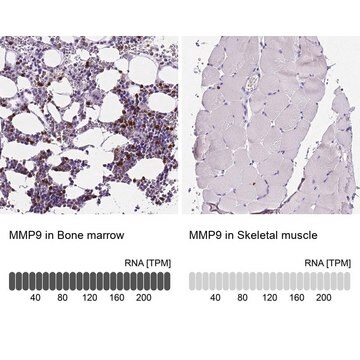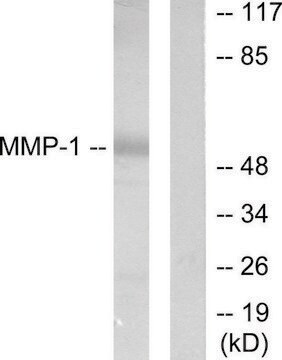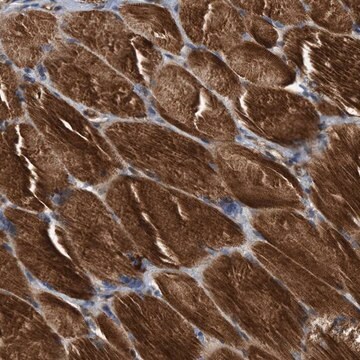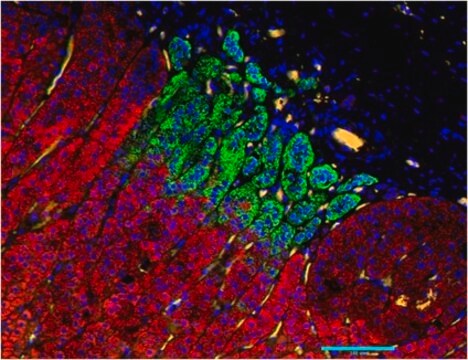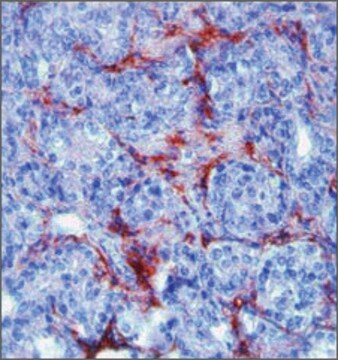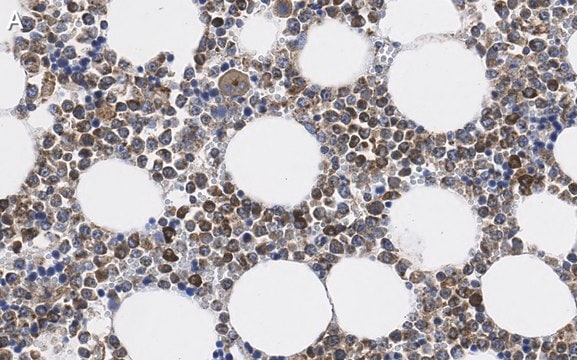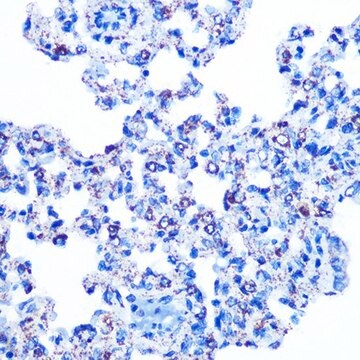MABT171
Anti-MMP-9 (Active) Antibody, clone 4A3
clone 4A3, from mouse
Synonym(s):
Matrix metalloproteinase-9, MMP-9, 92 kDa gelatinase, 92 kDa type IV collagenase, Gelatinase B, GELB
Sign Into View Organizational & Contract Pricing
Select a Size
All Photos(1)
Select a Size
Change View
About This Item
UNSPSC Code:
12352203
eCl@ss:
32160702
NACRES:
NA.41
Recommended Products
General description
Matrix metalloproteinase 9 (MMP-9), a member of the peptidase M10A family, is a multidomain zinc metalloproteinase enzyme, which is highly expressed in neurons and glia of the hippocampus, cerebral cortex, and cerebellum. The active MMP-9 is formed upon cell stimulation by enzymatic cleavage of the precursor, proMMP-9. Because of its function in tissue degradation, MMP-9 is tightly regulated by multiple mechanisms, including glycosylation, inhibition by TIMP1, internalization, and sequestration. MMP-9 plays an important role in long-term potentiation, synaptic plasticity, and memory. Several studies have reported an increase in levels of MMP-9 after CNS injury, as well during the development of various cancers.
Specificity
This antibody recognizes the N-terminus of MMP-9 (Active).
Immunogen
Epitope: N-terminus
Ovalbumin-conjugated linear peptide corresponding to the N-terminus of human MMP-9 (Active).
Application
Research Category
Cell Structure
Cell Structure
Research Sub Category
MMPs & TIMPs
MMPs & TIMPs
This Anti-MMP-9 (Active) Antibody, clone 4A3 is validated for use in Western Blotting, IHC for the detection of MMP-9 (Active).
Western Blot Analysis: A representative lot from an independent laboratory detected the active form of MMP-9 in WB (Duncan, M. E., et al. 1998. Eur J Biochem. 258(1):37-43).
Immunohistochemistry Analysis: A representative lot from an independent laboratory detected the active form of MMP-9 in oesophageal cancer tissues (Duncan, M. E., et al. 1998. Eur J Biochem. 258(1):37-43).
Immunohistochemistry Analysis: A representative lot from an independent laboratory detected the active form of MMP-9 in oesophageal cancer tissues (Duncan, M. E., et al. 1998. Eur J Biochem. 258(1):37-43).
Quality
Evaluated by Western Blot with the active form of MMP-9.
Western Blot Analysis: A 1:250 dilution from a reprsentative lot detected the active form of MMP-9 in WB.
Western Blot Analysis: A 1:250 dilution from a reprsentative lot detected the active form of MMP-9 in WB.
Target description
~67 kDa observed. Under reducing conditions in SDS-PAGE, MMP-9 monomer (proenzyme) is observed as a major band at ~ 92 kDa Activation of MMP-9 proenzyme with trypsin yields different active forms at ~64, ~67, and ~82 kDa in a time dependent manner (Duncan, M. E., et al. 1998. Eur J Biochem. 258(1):37-43).
Physical form
Format: Purified
Protein G Purified
Purified mouse monoclonal IgG1κ in buffer containing 0.1 M Tris-Glycine (pH 7.4), 150 mM NaCl with 0.05% sodium azide.
Storage and Stability
Stable for 1 year at 2-8°C from date of receipt.
Analysis Note
Control
Active form of MMP-9
Active form of MMP-9
Disclaimer
Unless otherwise stated in our catalog or other company documentation accompanying the product(s), our products are intended for research use only and are not to be used for any other purpose, which includes but is not limited to, unauthorized commercial uses, in vitro diagnostic uses, ex vivo or in vivo therapeutic uses or any type of consumption or application to humans or animals.
Not finding the right product?
Try our Product Selector Tool.
Storage Class
12 - Non Combustible Liquids
wgk_germany
WGK 1
flash_point_f
Not applicable
flash_point_c
Not applicable
Certificates of Analysis (COA)
Search for Certificates of Analysis (COA) by entering the products Lot/Batch Number. Lot and Batch Numbers can be found on a product’s label following the words ‘Lot’ or ‘Batch’.
Already Own This Product?
Find documentation for the products that you have recently purchased in the Document Library.
Fei Zhao et al.
Cancer immunology research, 6(12), 1459-1471 (2018-09-14)
Although anti-PD-1 therapy has improved clinical outcomes for select patients with advanced cancer, many patients exhibit either primary or adaptive resistance to checkpoint inhibitor immunotherapy. The role of the tumor stroma in the development of these mechanisms of resistance to
Our team of scientists has experience in all areas of research including Life Science, Material Science, Chemical Synthesis, Chromatography, Analytical and many others.
Contact Technical Service